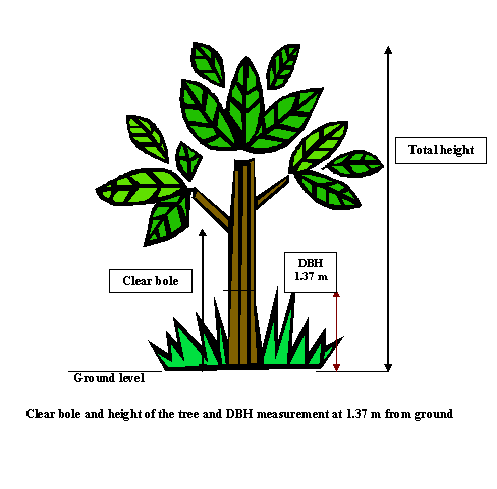


CHAPTER IV: Volume tables and equations The main objective of a TOF inventory is to estimate the growing stock, which is essential for sound management, planning and policy formulation. For management purposes, the user is often concerned with determining the volume of a large number of trees of distinct dimensions. To do this requires volume tables. Volume tables are based on diameter and/or height and/or tree form. They are often derived via volume equations that are statistically sound and based of regression analysis. A volume table of a particular species is defined as a table showing the average volume of trees, logs or sawntimber for one or more given characteristics such as DBH alone or DBH and height or DBH, height and form or taper. The main objective of volume tables is to facilitate estimating the average volume of standing trees for which the diameter and height are known. The volume is based on the actual volume measurements of some 40 to 50 felled or standing trees of all diameter classes. It is based on the assumption that individuals of the same species, with the same DBH, or DBH and height have, on average, the same volume (given identical growing conditions). Thus, volume tables can be classified into three categories according to the number of independent variables (one to three) i.e. DBH, height and/or taper. The development of a volume table requires volume equations for the species in question. There are three types of volume equations based on the number of variables and objectives. Each type is formulated by means of regression analysis: Regional volume equation: This type of equation is normally based on two variables (e.g. DBH and height) and covers a larger geographical area. Regional volume equations are standard volume equations with limited application. Care needs to be taken that the trees measured, for the formulation of this equation, are truly representative of the variation encountered in the region. A local volume equation can be easily prepared from a standard or regional volume equation by analysing the DBH/height relationship of the species for the given location. There are two methods available to generate volume tables namely, the destructive and the non-destructive method. In this method, 40-50 individuals of a particular species, representing all diameter classes of interest are selected randomly and felled. Each tree is cut into appropriate lengths of logs, generally between 2-3 m. The volume of each log is calculated individually, using suitable formulae, generally Huberís formula for parabolides, cylindrical, conical or Newtonís formula for neiloidic form. The volume of each individual log is added to obtain the total volume of the tree. This is similar to the destructive method but the trees are not felled. Diameters are measured at different heights by climbing the trees. Tree height is estimated with the help of e.g. an altimeter, a clinometer, a cruiser stick or a relaskop. The volume is then calculated using the same formulae as above. Volume tables can be prepared for particular species, on the basis of these calculations. The trees to be measured are selected randomly. The DBH is measured twice to the nearest millimeter, perpendicular to each other, over bark. Both the height and the diameter are recorded in a table. After the measurements have been taken, the trees are felled. The first log is marked at 2.74 m (with the DBH in the centre) and the DBH taken as the girth. The rest of the bole is divided into sections of 3 m length and mid girth of each section is recorded at the middle of the log. The last section is allowed to vary between 2 to 4 meters. The lowest diameter limit fixed for the measurement is generally 5 cm. Similar measurements are carried out for all the branches.Volume tables
Volume equations
Preparation of volume tables
Destructive method
Non-destructive method
Data collection for preparation of volume tables
